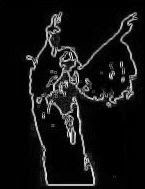I believe that Malcolm Muggeridge first alerted me to the distinction between looking at and looking with. Was it in his fine End of Christendom (1980), in which St. Mugg reflected on William Blake's "seeing with" not "through" the eye? I cannot recall, but I have come across the useful distinction in CS Lewis's writings.
Looking at is the approach of analysis, the poking and prodding, even dissecting, of a thing to discover its parts, its mechanisms, etc. Looking at also signifies the steps taken to uncover the processes by which a thing came to be -- philosophically a much more difficult form of reasoning since historical processes cannot be verified.
Looking with signifies meaning making: first, seeing what a thing sees; secondly, the process of understanding and valuing.
I am not sure how far I would press this, but it seems looking at reflects the approach of science, whereas looking with is identified with philosophy, theology and the arts.
Looking at the human person, then, might signify biochemical or psychological analysis. I struggled with biology in college, but I can at least recall that it was intended to identify the way in which the body functions. (Chemistry made more sense because of the molecule kits.) Two decades ago the biochemical worth of the human person was under $20. Perhaps certain body parts are of more economic value, some detached from the body of a person (e.g., heart, liver) and some not (i.e., sexually receptive parts). Demand impacts worth here, in the realm of looking at.
But is this the value of the human person? Looking with the person reveals the sense of being more than the sum of one's parts or more than the value in trade. I understand that I am worth X dollars biochemically or economically, but this material worth does not reflect my sense that I am, as CS Lewis noted, a fish-out-of-water, a person who is aware that he has a longing for something higher, something beyond the mere appearances, the mere material aspects of human existence.
Scientific looking at cannot uncover the awareness of freedom (for example) that the human person expresses. There is no centrifuge to separate human rights from animal drives. One must look with art, poetry, music, philosophy, and -- yes -- theology to discover the value of human life.
Human persons express a something more in their art and music, a looking with. The negativity projected in modern art and music unveils the person's experience of disappointment and despair. Looking with this negativity might suggest that the person is hopeless, fated for desperation and futility, but it also signifies the awareness of the something more, the longing for one's true home, a higher calling. [8.23.08]

No comments:
Post a Comment